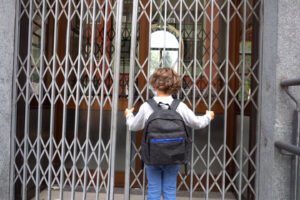‘Risky play’ promotes physical and mental health while teaching kids sound character traits
The idea of “risky play” may cause some parents to faint, but encouraging kids to play without adult supervision can reduce their chances of experiencing anxiety, depression and obesity.
It…

The idea of “risky play” may cause some parents to faint, but encouraging kids to play without adult supervision can reduce their chances of experiencing anxiety, depression and obesity.
It also helps them develop characteristics such as courage, self-awareness and sound judgment.
So say the authors of a new report released Thursday by the Canadian Paediatric Society (CPS).
“Children engaged in free play are also building social and executive functioning skills that are critical for school readiness and lifelong achievement,” assert Dr. Émilie Beaulieu, Dr. Suzanne Beno, and their colleagues at CPS, in the report titled “Healthy childhood development through outdoor risky play: Navigating the balance with injury prevention.”
The report suggests the trend of attempting to eliminate most risk in children’s lives has contributed to a greater tendency for play to be moved indoors, and often on “screens.”
“Over the last several decades, family and social trends have increasingly prioritized the supervision and protection of children,” the authors write. “A shift in the balance of play has also occurred, with unscheduled free play outdoors steadily giving way to planned, structured activities, including extra-curriculars and academics, in the lives of most children.
“Children are spending more of their recreational time indoors (and often on screens) than playing outside with minimal supervision.”
Following grades of “D” and “D-” given to Canadian children for overall physical activity and active play on the 2022 ParticipACTION report card, the researchers noted many Canadian groups are calling for a “shift in strategies to keep children ‘as safe as necessary’ rather than ‘as safe as possible,’’’ and “a more balanced approach to healthy and active living that encourages the developmental benefits of risk-taking as well as preventing injury.”
Though most parents would at least intellectually agree that “free play” is necessary for children’s physical and psychological well-being, the researchers’ premise that the notion of eliminating most risk from children’s lives has cemented itself in daily life is readily apparent.
Drivers, for example, are faced with that reality each day when stalled behind a school bus that is required to stop – even in suburban areas – at every single home to pick up and drop off children.
Two or three decades ago, children might have enjoyed not only a brisk and healthy walk with friends to or from a bus stop central to a larger area, but also, perhaps, an adventurous play experience or opportunity to observe things in nature along the route.
The researchers define “risky play” as “thrilling and exciting forms of free play that involve uncertainty of outcome and a possibility of physical injury.”
Supporters of risky play differentiate between “risk” and “hazard,” the authors say, and hope to encourage the perception that risk is “an opportunity for situational evaluation and personal development.”
A “risk” arises when a child “can recognize and evaluate the challenge and decide on a course of action based on personal preference and self-perceived skill,” they explain, such as in the case of a child determining how high to climb a structure or rock, or how fast to run down a hill.
A “hazard,” however, is presented when “the potential for injury is beyond the child’s capacity to recognize it as such or to manage it.” In this case, a child may not be able to accurately assess that a tree limb that is rotted may cause him to fall, even though he perceives it to be at a comfortable height for climbing.
Norway’s Ellen Sandseter has investigated how risk-taking can be identified in children’s play. A 2007 study based on observations and interviews with preschoolers and their teachers found six categories of risky play which Beaulieu et al. elaborated upon in their report:
- Height and elevation, such as climbing and jumping;
- Speed and momentum, such as bicycling, running or sledding at high speed;
- Use of risky or adult tools, such as supervised building activities with an axe, saw, knife, etc.;
- Interaction with natural elements, such as play near fire or water;
- Play with a chance of “getting lost” – hiding in the bushes or wandering in the woods;
- Rough-and-tumble play- play fighting, wrestling.
The authors explain injuries experienced during risky play generally involve abrasions, contusions and lacerations. They also point to research that has found children are less likely to be injured while engaging in unstructured play activities than when playing an organized sport.
The report’s authors, however, make clear what “risky play” is not:
- Ignoring evidence-based and mandated safety measures (e.g., the use of helmets, car seats, life jackets, stair safety gates);
- Leaving children unsupervised in potentially hazardous situations (e.g., street play in traffic areas);
- Pushing children to take risks beyond their own comfort level.
A resource located at the Boston University Children’s Center website explains further the benefits of risky play: “Risky play helps children develop resilience, executive functioning skills, self-confidence, and risk-assessment abilities.
“Each time they engage in risky play they are engaging in their own science experiment: pushing themselves out of their comfort zone without knowing what the exact outcome will be. Risky play allows children to learn their own limits and find out what they feel comfortable with. This awareness helps reduce the risk of injury as children learn to identify the point when they might need to stop to reassess the situation.”
Instead of providing children with a bombardment of warnings about “being safe,” the resource encourages parents to put their own fears aside in order to engage with their child in a “problem-solving process” that can provide a basis for the development of his or her own independent risk assessment skills.
Cautions such as “Be careful,” can be replaced with other phrases to help foster a child’s awareness:
- Notice how … these rocks are slippery, the log is rotten, that branch is strong.
- Do you see … the poison ivy, your friends nearby?
- Try moving … your feet slowly, carefully, quickly, strongly.
- Do you feel … stable on that rock, the heat from the fire?
- Are you feeling … scared, excited, tired, safe?
Similarly, parents can model problem-solving with their child in a risky play situation:
- What’s your plan … if you climb that boulder, cross that log?
- What can you use … to get across, for your adventure?
- Where will you … put that rock, climb that tree, dig that hole?
- How will you … get down, go up, get across?
- Who will … be with you, go with you, help you if…?
“Some experts have suggested that parents practice pausing for 15 to 30 seconds to observe children’s ‘state of play’ before intervening,” the report says.
“The length of this pause depends on the individual child, situation, and activity being observed. When parents do intervene, their first focus can be on raising a child’s awareness of a situation or behaviour, then helping the child to manage a predicament or problem-solve.”



